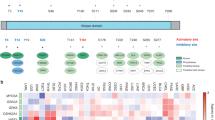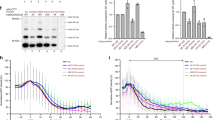Abstract
Cyclin C belongs to the cyclin family of proteins that control cell cycle transitions through activation of specific catalytic subunits, the cyclin-dependent kinases (CDKs). However, there is as yet no evidence for any role of cyclin C and its partner, cdk8, in cell cycle regulation. Rather, the cyclin C-cdk8 complex was found associated with the RNA polymerase II transcription machinery. The periodic degradation of bona fide cyclins is crucial for cell-cycle progression and depends on the catalytic activity of the associated CDK. Here we show that endogenous cyclin C protein is quite stable with a half-life of 4 h. In contrast, exogenously expressed cyclin C is very unstable (half-life 15 min) and degraded by the ubiquitin-proteasome pathway. Co-expression with its associated cdk, however, strongly stabilizes cyclin C and results in a protein half-life near that of endogenous cyclin C. In stark contrast to data reported for other members of the cyclin family, both catalytically active and inactive cdk8 induce cyclin C stabilization. Moreover, this stabilization is accompanied in both cases by phosphorylation of the cyclin, which is not detectable when unstable. Our results indicate that cyclin C has apparently diverged from other cyclins in the regulation of its stability by its CDK partner.
This is a preview of subscription content, access via your institution
Access options
Subscribe to this journal
Receive 50 print issues and online access
$259.00 per year
only $5.18 per issue
Buy this article
- Purchase on Springer Link
- Instant access to full article PDF
Prices may be subject to local taxes which are calculated during checkout








Similar content being viewed by others
References
Arellano M and Moreno S. . 1997 Int. J. Biochem. Cell. Biol. 29: 559–573.
Balciunas D and Ronne H. . 1995 Nucleic Acids Res. 23: 4421–4425.
Boyer TG, Martin ME, Lees E, Ricciardi RP and Berk AJ. . 1999 Nature 399: 276–279.
Carlson M, Osmond BC, Neigeborn L and Botstein D. . 1984 Genetics 107: 19–32.
Cho H, Orphanides G, Sun X, Yang XJ, Ogryzko V, Lees E, Nakatani Y and Reinberg D. . 1998 Mol. Cell. Biol. 18: 5355–5363.
Chomczynski P and Sacchi N. . 1987 Anal. Biochem. 162: 156–159.
Church GM and Gilbert W. . 1984 Proc. Natl. Acad. Sci. USA 81: 1991–1995.
Ciechanover A. . 1998 EMBO J. 17: 7151–7160.
Clurman BE, Sheaff RJ, Thress K, Groudine M and Roberts JM. . 1996 Genes Dev. 10: 1979–1990.
Coleman KG, Wautlet BS, Morrissey D, Mulheron J, Sedman SA, Brinkley P, Price S and Webster KR. . 1997 J. Biol. Chem. 272: 18869–18874.
Cooper KF, Mallory MJ, Smith JB and Strich R. . 1997 EMBO J. 16: 4665–4675.
Dautry F, Weil D, Yu J and Dautry-Varsat A. . 1988 J. Biol. Chem. 263: 17615–17620.
DeMartino GN and Slaughter CA. . 1999 J. Biol. Chem. 274: 22123–22136.
Diehl JA, Cheng M, Roussel MF and Sherr CJ. . 1998 Genes Dev. 12: 3499–3511.
Diehl JA, Zindy F and Sherr CJ. . 1997 Genes Dev. 11: 957–972.
Dulic V, Lees E and Reed SI. . 1992 Science 257: 1958–1961.
Evans T, Rosenthal ET, Youngblom J, Distel D and Hunt T. . 1983 Cell 33: 389–396.
Germain D, Russell A, Thompson A and Hendley J. . 2000 J. Biol. Chem. 275: 12074–12079.
Gold MO, Tassan JP, Nigg EA, Rice AP and Herrmann CH. . 1996 Nucleic Acids Res. 24: 3771–3777.
Gossen M and Bujard H. . 1992 Proc. Natl. Acad. Sci. USA 89: 5547–5551.
Gu W, Malik S, Ito M, Yuan CX, Fondell JD, Zhang X, Martinez E, Qin J and Roeder RG. . 1999 Mol. Cell. 3: 97–108.
Hautbergue G and Goguel V. . 1999 Mol. Cell. Biol. 19: 2527–2534.
Hershko A and Ciechanover A. . 1998 Annu. Rev. Biochem. 67: 425–479.
Hinds PW, Mittnacht S, Dulic V, Arnold A, Reed SI and Weinberg RA. . 1992 Cell 70: 993–1006.
Hirst M, Kobor MS, Kuriakose N, Greenblatt J and Sadowski I. . 1999 Mol. Cell. 3: 673–678.
Koepp DM, Harper JW and Elledge SJ. . 1999 Cell 97: 431–434.
Kuchin S and Carlson M. . 1998 Mol. Cell. Biol. 18: 1163–1171.
Kuchin S, Yeghiayan P and Carlson M. . 1995 Proc. Natl. Acad. Sci. USA 92: 4006–4010.
Lahue EE, Smith AV and Orr-Weaver TL. . 1991 Genes Dev. 5: 2166–2175.
Lania L, Majello B and Napolitano G. . 1999 J. Cell. Physiol. 179: 134–141.
Lanker S, Valdivieso MH and Wittenberg C. . 1996 Science 271: 1597–1601.
Leclerc V, Tassan JP, O'Farrell PH, Nigg EA and Leopold P. . 1996 Mol. Biol. Cell. 7: 505–513.
Lee DH and Goldberg AL. . 1998 Trends Cell Biol. 8: 397–403.
Leopold P and O'Farrell PH. . 1991 Cell 66: 1207–1216.
Lew DJ, Dulic V and Reed SI. . 1991 Cell 66: 1197–1206.
Liao SM, Zhang J, Jeffery DA, Koleske AJ, Thompson CM, Chao DM, Viljoen M, van Vuuren HJ and Young RA. . 1995 Nature 374: 193–196.
Maldonado E, Shiekhattar R, Sheldon M, Cho H, Drapkin R, Rickert P, Lees E, Anderson CW, Linn S and Reinberg D. . 1996 Nature 381: 86–89.
Matsushime H, Roussel MF, Ashmun RA and Sherr CJ. . 1991 Cell 65: 701–713.
Nigg EA. . 1996 Curr. Opin. Cell. Biol. 8: 312–317.
Pagano M. . 1997 FASEB J. 11: 1067–1075.
Pines J and Hunter T. . 1990 Nature 346: 760–763.
Rickert P, Corden JL and Lees E. . 1999 Oncogene 18: 1093–1102.
Rickert P, Seghezzi W, Shanahan F, Cho H and Lees E. . 1996 Oncogene 12: 2631–2640.
Sambrook J, Fritsch EF and Maniatis T. . 1989 Molecular Cloning: A Laboratory Manual, 2nd edn. Cold Spring Harbor Laboratory Press: Cold Spring Harbor, NY.
Singer JD, Gurian-West M, Clurman B and Roberts JM. . 1999 Genes Dev. 13: 2375–2387.
Strich R, Slater MR and Esposito RE. . 1989 Proc. Natl. Acad. Sci. USA 86: 10018–10022.
Sun X, Zhang Y, Cho H, Rickert P, Lees E, Lane W and Reinberg D. . 1998 Mol. Cell. 2: 213–222.
Surosky RT, Strich R and Esposito RE. . 1994 Mol. Cell. Biol. 14: 3446–3458.
Tassan JP, Jaquenoud M, Leopold P, Schultz SJ and Nigg EA. . 1995 Proc. Natl. Acad. Sci. USA 92: 8871–8875.
Wei P, Garber ME, Fang SM, Fischer WH and Jones KA. . 1998 Cell 92: 451–462.
Won KA and Reed SI. . 1996 EMBO J. 15: 4182–4193.
Yaglom J, Linskens MH, Sadis S, Rubin DM, Futcher B and Finley D. . 1995 Mol. Cell. Biol. 15: 731–741.
Yam CH, Siu WY, Lau A and Poon RY. . 2000 J. Biol. Chem. 275: 3158–3167.
Acknowledgements
We thank H Bujard, R Dynan, P Hinds, C Sardet and M Trier for providing plasmids and P Dariavach for the anti-HA 12CA5 antibody. We are grateful to V Dulic for the gift of anti-cyclin D1 antibody, help with making anti-cyclin C antibody and discussions. We also thank P Bello and D Fesquet for a critical review of the manuscript. This work was supported by the Centre National de la Recherche Scientifique, the Association pour la Recherche sur le Cancer and the Ligue Nationale Contre Le Cancer. C.B. was supported by a grant from the French Ministère de la Recherche and the Association pour la Recherche sur le Cancer.
Author information
Authors and Affiliations
Rights and permissions
About this article
Cite this article
Barette, C., Jariel-Encontre, I., Piechaczyk, M. et al. Human cyclin C protein is stabilized by its associated kinase cdk8, independently of its catalytic activity. Oncogene 20, 551–562 (2001). https://doi.org/10.1038/sj.onc.1204129
Received:
Revised:
Accepted:
Published:
Issue Date:
DOI: https://doi.org/10.1038/sj.onc.1204129
Keywords
This article is cited by
-
Cdk8
AfCS-Nature Molecule Pages (2006)
-
Cyclin C
AfCS-Nature Molecule Pages (2006)
-
Autophagy in innate and adaptive immunity against intracellular pathogens
Journal of Molecular Medicine (2006)



